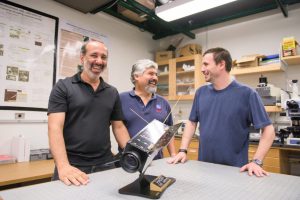HARP Instrument Proved New Approach for Atmospheric Aerosol Measurements

Vanderlei Martins, Roberto Borda, and Dominik Cieslak with a full-size model of HARP at UMBC. (Credit: Marlayna Demond for UMBC)
Before deorbiting in April 2022, the Hyper-Angular Rainbow Polarimeter (HARP) CubeSat spent 777 days in low Earth orbit validating a novel, compact imaging polarimeter designed to observe atmospheric aerosols.
The HARP polarimeter observed how light scatters off of aerosols – airborne particles that have an impact on many variables, from air pollution to climate change – to determine their size, shape, and chemical composition. Before HARP, researchers were unsure whether small satellites were capable of hosting such an instrument.
Led by Jose Vanderlei Martins, Director of the Earth and Space Institute at the University of Maryland, Baltimore County (UMBC), a team of scientists developed a polarimeter that splits three identical images into independent detector arrays using a unique prism. This allowed HARP to achieve highly-accurate, simultaneous imagery of three polarization states with minimal hardware.
In 2020, the 3-unit CubeSat won the 2020 “Small Satellite Mission of the Year” award from the American Institute of Aeronautics and Astronautics. HARP also has the distinction of being the 100th CubeSat mission supported by NASA’s CubeSat Launch initiative.
Other NASA missions have already used – or plan to use – identical HARP instruments to monitor aerosol-cloud interactions from aircraft and space-based platforms.
Two airborne campaigns – NASA’s Aerosol Characterization from Polarimeter and Lidar (ACEPOL) and the Lake Michigan Ozone Study (LMOS) – relied heavily on technology innovations first pioneered by HARP. Both campaigns used an airborne version of the space instrument known as AirHARP to observe aerosol particles and clouds.
Vanderlei and his team are also developing HARP-2 for NASA’s Plankton, Aerosol, Cloud, ocean Ecosystem (PACE) mission, which will help us better understand how the ocean and the atmosphere exchange carbon dioxide. HARP-2’s role will be to reveal how aerosols might fuel phytoplankton growth in the uppermost area of the ocean surface.